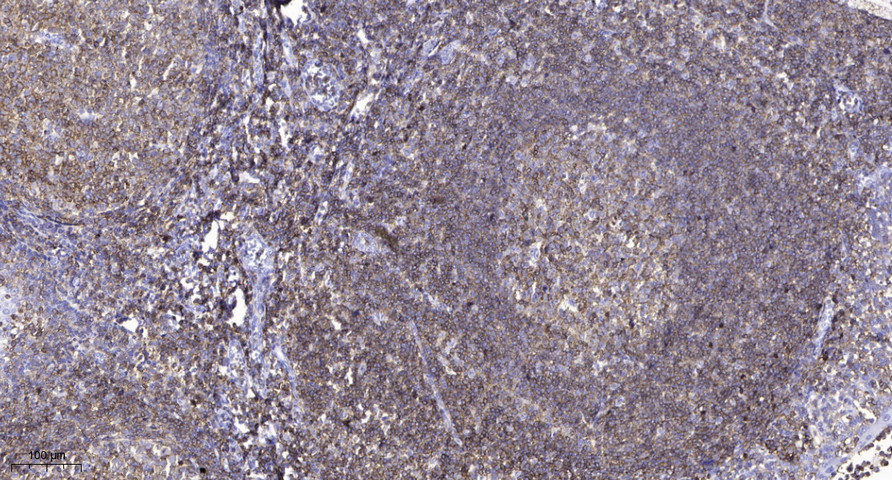OCT1 Monoclonal Antibody
- Catalog No.:YT6172
- Applications:IHC;IF;WB
- Reactivity:Human;Rat;Mouse;
- Target:
- OCT1
- Fields:
- >>Bile secretion;>>Choline metabolism in cancer
- Gene Name:
- SLC22A1 OCT1
- Protein Name:
- 45200
- Human Gene Id:
- 6580
- Human Swiss Prot No:
- O15245
- Immunogen:
- Synthesized peptide derived from human OCT1 Monoclonal Antibody
- Specificity:
- This antibody detects endogenous levels of human OCT1 Monoclonal Antibody
- Formulation:
- Liquid in PBS containing 50% glycerol, 0.5% BSA and 0.02% sodium azide.
- Source:
- Polyclonal, Rabbit,IgG
- Dilution:
- IHC 1:50-200, WB 1:500-2000. IF 1:50-200
- Purification:
- The antibody was affinity-purified from rabbit antiserum by affinity-chromatography using epitope-specific immunogen.
- Concentration:
- 1 mg/ml
- Storage Stability:
- -15°C to -25°C/1 year(Do not lower than -25°C)
- Other Name:
- Solute carrier family 22 member 1 (Organic cation transporter 1;hOCT1)
- Observed Band(KD):
- 61kD
- Background:
- Polyspecific organic cation transporters in the liver, kidney, intestine, and other organs are critical for elimination of many endogenous small organic cations as well as a wide array of drugs and environmental toxins. This gene is one of three similar cation transporter genes located in a cluster on chromosome 6. The encoded protein contains twelve putative transmembrane domains and is a plasma integral membrane protein. Two transcript variants encoding two different isoforms have been found for this gene, but only the longer variant encodes a functional transporter. [provided by RefSeq, Jul 2008],
- Function:
- caution:The sequence shown here is derived from an Ensembl automatic analysis pipeline and should be considered as preliminary data.,function:Translocates a broad array of organic cations with various structures and molecular weights including the model compounds 1-methyl-4-phenylpyridinium (MPP), tetraethylammonium (TEA), N-1-methylnicotinamide (NMN), 4-(4-(dimethylamino)styryl)-N-methylpyridinium (ASP), the endogenous compounds choline, guanidine, histamine, epinephrine, adrenaline, noradrenaline and dopamine, and the drugs quinine, and metformin. The transport of organic cations is inhibited by a broad array of compounds like tetramethylammonium (TMA), cocaine, lidocaine, NMDA receptor antagonists, atropine, prazosin, cimetidine, TEA and NMN, guanidine, cimetidine, choline, procainamide, quinine, tetrabutylammonium, and tetrapentylammonium. Translocates organic cations in an electroge
- Subcellular Location:
- Basolateral cell membrane ; Multi-pass membrane protein .
- Expression:
- Widely expressed with high level in liver. Isoform 1 and isoform 2 are expressed in liver. Isoform 1, isoform 2, isoform 3 and isoform 4 are expressed in glial cell lines.
A prognostic model built on amino acid metabolism patterns in HPV-associated head and neck squamous cell carcinoma ARCHIVES OF ORAL BIOLOGY Fengyang Jing IHC Human 1:200 oral squamous cell carcinoma tissue
- June 19-2018
- WESTERN IMMUNOBLOTTING PROTOCOL
- June 19-2018
- IMMUNOHISTOCHEMISTRY-PARAFFIN PROTOCOL
- June 19-2018
- IMMUNOFLUORESCENCE PROTOCOL
- September 08-2020
- FLOW-CYTOMEYRT-PROTOCOL
- May 20-2022
- Cell-Based ELISA│解您多样本WB检测之困扰
- July 13-2018
- CELL-BASED-ELISA-PROTOCOL-FOR-ACETYL-PROTEIN
- July 13-2018
- CELL-BASED-ELISA-PROTOCOL-FOR-PHOSPHO-PROTEIN
- July 13-2018
- Antibody-FAQs
- Products Images

- Immunohistochemical analysis of paraffin-embedded human tonsil. 1, Antibody was diluted at 1:200(4° overnight). 2, Tris-EDTA,pH9.0 was used for antigen retrieval. 3,Secondary antibody was diluted at 1:200(room temperature, 45min).



